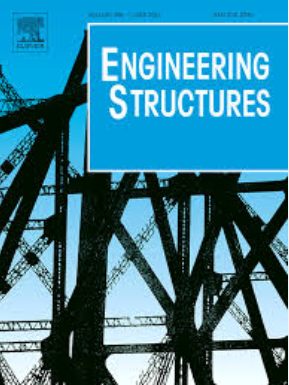Low-damage performance of rocking column bases with Belleville Springs for enhanced seismic resilience
IF 5.6
1区 工程技术
Q1 ENGINEERING, CIVIL
引用次数: 0
Abstract
This paper investigates the low-damage performance of strong axis-aligned asymmetric friction connection (SAFC) column bases, with a focus on enhancing seismic resilience through the incorporation of Belleville Springs (BeSs). Cyclic loading tests were performed along the strong axis of the column, considering three cases: INITIAL (as-built), AFTERSHOCK (post-testing without repair), and REPAIR (restored condition via bolt re-tightening or replacement), with a maximum drift of 3 %. In the absence of BeSs, the column base exhibited a 22.9 % reduction in initial rotational stiffness and a 13.6 % decrease in ultimate moment resistance in the AFTERSHOCK case. However, the use of BeSs maintained the bolts within the elastic range, resulting in near-identical hysteretic behavior across all cases, with losses in stiffness and strength remaining within 7 %. Both column base configurations, with and without BeSs, exhibited satisfactory performance restoration in the REPAIR case. A finite element analysis (FEA) model was developed to quantitatively evaluate the low-damage performance, sliding behavior, bolt pre-tension loss, and energy dissipation of the column base. The findings showed that BeSs improved seismic resilience by mitigating bolt pre-tension loss and minimizing plastic deformation. Finally, a simplified flag-shaped hysteretic model was proposed and validated through test results.
求助全文
约1分钟内获得全文
求助全文
来源期刊

Engineering Structures
工程技术-工程:土木
CiteScore
10.20
自引率
14.50%
发文量
1385
审稿时长
67 days
期刊介绍:
Engineering Structures provides a forum for a broad blend of scientific and technical papers to reflect the evolving needs of the structural engineering and structural mechanics communities. Particularly welcome are contributions dealing with applications of structural engineering and mechanics principles in all areas of technology. The journal aspires to a broad and integrated coverage of the effects of dynamic loadings and of the modelling techniques whereby the structural response to these loadings may be computed.
The scope of Engineering Structures encompasses, but is not restricted to, the following areas: infrastructure engineering; earthquake engineering; structure-fluid-soil interaction; wind engineering; fire engineering; blast engineering; structural reliability/stability; life assessment/integrity; structural health monitoring; multi-hazard engineering; structural dynamics; optimization; expert systems; experimental modelling; performance-based design; multiscale analysis; value engineering.
Topics of interest include: tall buildings; innovative structures; environmentally responsive structures; bridges; stadiums; commercial and public buildings; transmission towers; television and telecommunication masts; foldable structures; cooling towers; plates and shells; suspension structures; protective structures; smart structures; nuclear reactors; dams; pressure vessels; pipelines; tunnels.
Engineering Structures also publishes review articles, short communications and discussions, book reviews, and a diary on international events related to any aspect of structural engineering.
 求助内容:
求助内容: 应助结果提醒方式:
应助结果提醒方式:


